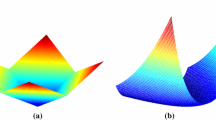Abstract
The conventional self-organizing feature map (SOM) algorithm is usually interpreted as a computational model, which can capture main features of computational maps in the brain. In this paper, we present a variant of the SOM algorithm called the SOM-based optimization (SOMO) algorithm. The development of the SOMO algorithm was motivated by exploring the possibility of applying the SOM algorithm in continuous optimization problems. Through the self-organizing process, good solutions to an optimization problem can be simultaneously explored and exploited by the SOMO algorithm. In our opinion, the SOMO algorithm not only can be regarded as a biologically inspired computational model but also may be regarded as a new approach to a model of social influence and social learning. Several simulations are used to illustrate the effectiveness of the proposed optimization algorithm.



Similar content being viewed by others
References
Holland JH (1975) Adaptation in natural and artificial systems. University of Michigan Press, Ann Arbor
DE Goldberg (1989) Genetic algorithms in search, optimization, and machine learning. Addison-Wesley, Reading
Fogel LJ (1994) Evolutionary programming in perspective: the top-down view. In: Zurada JM, Marks RJ II, Robinson CJ (eds) Computational intelligence imitating life. IEEE Press, Piscataway
Rechenberg I (1994) Evolution strategy, in computational intelligence: imitating life. In: Zurada JM, Marks RJ II, Robinson CJ (eds) Computational intelligence imitating life. IEEE Press, Piscataway
Kennedy J, Eberhart RC, Shi Y (2001) Swarm intelligence. Academic Press, New York
Eberhart R, Kennedy JA (1995) New optimizer using particle swarm theory. In: Proceedings of the 6th international symposium on micro machine and human science, Oct 1995, pp 39–43
Kennedy J, Eberhart R (1995) Particle swarm optimization. In: IEEE international conference on neural networks, Dec 1995, vol 4, pp 1942–1948
Kohonen T (1989) Self-organization and associative memory, 3rd edn. Springer, New York
Kohonen T (2001) Self-organization maps, 3rd extended edn. Springer, Heidelberg
Kohonen T, Oja E, Simula O, Visa A, Kangas J (1996) Engineering application of the self-organizing map. Proc IEEE 84(10):1358–1383
Willshaw DJ, von der Malsburg C (1976) How patterned neural connections can be set up by self-organization. Proc R Soc Lond Ser B 194:431–445
Kaski S, Kangas J, Kohonen T (1998) Bibliography of self-organizing map (SOM) papers: 1981–1997. Neural Comput Surv 1:102–350
Oja M, Kaski S, Kohonen T (2003) Bibliography of self-organizing map (SOM) papers: 1998–2001 addendum. Neural Comput Surv 3(1):1–156
Yin H (2008) The self-organizing maps: background, theories, extensions and applications. Springer, Berlin
Angeniol B, Vaubois GDLC, Texier JYL (1988) Self-origanizing feature maps and the travelling salesman problem. Neural Netw 1:289–293. doi:10.1016/0893-6080(88)90002-0
Fujimura K, Tokutaka H, Ohshima Y, Kishida S (1994) The traveling salesman problem applied to the self-organizing feature map. In: Proceedings of international conference on neural information processing, pp 427–432
Fujimura K, Tokutaka H (1999) SOM-TSP: an approach to optimize surface component mounting on a printed circuit board. In: Kohonen maps. Elsevier, Amsterdam, pp 219–230
Fujimura K, Kishida S, Kwaw OC, Tokutaka H (2001) Optimization of electronic chip-mounting machine using SOM-TSP method with 5 dimensional data. In: Proceedings of international conference on info-tech and info-net (ICII 2001-Beijing), vol 4, pp 26–31
Vieira F, Neto A, Cosya J (2002) An efficient approach of the SOM algorithm to the traveling salesman problem. In: Proceedings of the neuro networks (SBRN 2002), p 152
Dong JH, Sak LK, Leung WM, Yu ZB (2003) An efficient self-organizing map designed by genetic algorithms for the traveling salesman problem. IEEE Trans Syst Man Cybern 33:877–888. doi:10.1109/TSMCB.2002.804367
Su MC, Zhao YX, Lee J (2004) SOM-based optimization. In: IEEE international joint conference on neural networks, Budapest, pp 781–786
Su MC, Chang HC (2000) Fast self-organizing feature map algorithm. IEEE Trans Neural Netw 13(3):721–733
Su MC, Liu TK, Chang HT (1999) An efficient initialization scheme for the self-organizing feature map algorithm. IEEE international joint conference on neural networks, Washington, DC, pp 1906–1910
De Jong KA (1975) An analysis of the behaviour of a class of genetic adaptive systems. University of Michigan, Ann Arbor, University Microfilms No. 76-9381
Fogel GB, Greenwood GW, Chellapilla K (2000) Evolutionary computation with extinction: experiments and analysis. In: Proceedings of the 2000 congress on evolutionary computation, pp 1415–1420
Salomon R (1995) Reevaluating genetic algorithm performance under coordinate rotation of benchmark functions—a survey of some theoretical and practical aspects of genetic algorithms. BioSystems 39:263–278
The software packages for the GAs and the PSO algorithm. www.engr.iupui.edu/~ebergart/web/PSObook.html
Blake CL, Merz CJ (1998) UCI repository of machine learning databases. http://www.ics.uci.edu/~mlearn/MLRepository.html
Kennedy J (1999) Small worlds and mega-minds: effects of neighborhood topology on particle swarm optimization. In: IEEE international conference on evolutionary computation, Dec 1999, pp 1931–1938
Kennedy J, Mendes R (2002) Topological structure and particle swarm performance. In: Proceedings of the congress on evolutionary computation, May 2002
Mendes R, Kennedy J, Neves J (2002) Watch thy neighbor or how the swarm can learn from its environment. In: Iberoamerican conference on artificial intelligence, Seville, Nov 2002
Kennedy J, Mendes R (2003) Neighborhood topologies in fully-informed and best-of-neighborhood particle swarms. In: IEEE SMC workshop on soft computing in industrial applications, Jun 2003
Acknowledgments
This work was partly supported by the National Science Council, Taiwan, ROC, under NSC 97-2631-S-008-003 and NSC 97-2631-H-008-001.
Author information
Authors and Affiliations
Corresponding author
Rights and permissions
About this article
Cite this article
Su, MC., Zhao, YX. A variant of the SOM algorithm and its interpretation in the viewpoint of social influence and learning. Neural Comput & Applic 18, 1043–1055 (2009). https://doi.org/10.1007/s00521-009-0278-7
Received:
Accepted:
Published:
Issue Date:
DOI: https://doi.org/10.1007/s00521-009-0278-7




